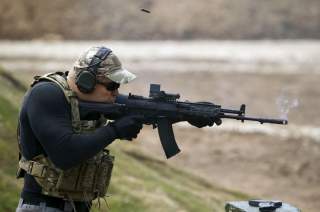Gun Facts: These Russian Rifles Surpass the AK-47
Meet the AK-12 and AK-15.
Key Point: The Kalishnakov design will last for the rest of the century.
The Russian armed forces serve eleven consecutive time zones, from Kaliningrad in the west to Khabarovsk in the far east. Moscow’s legions need a proven, capable assault rifle capable of performing under harsh environmental conditions, including snow, mud, and sand. The military’s latest assault rifles are a familiar sight: the AK-12 and AK-15 assault rifles are direct descendants of the legendary AK-47.
The AK-47 was the brainchild of Mikhail T. Kalashnikov, a Soviet Army tanker turned small arms designer. Kalashnikov designed a new rifle to replace both bolt action rifles and submachine guns in Soviet service. Kalashnikov’s rifle was meant to occupy the middle ground between the two. It utilized a new 7.62x39 round that had less power (and recoil) than the Mosin but greater range than a submachine gun. It was shorter than the Mosin Nagant rifle, allowing it to fit inside vehicles of the increasingly mechanized Soviet Army, but still had a barrel long enough to give it an effective range of four hundred meters. The AK-47 had the firepower of the wartime PPsh41 submachine gun gun, capable of fully automatic fire and taking ammunition from a detachable thirty-round steel magazine.
The AK-47 was adopted by the Soviet Army in 1947, and for years was considered a state secret. The AK-47 was replaced by the AKM in the 1960s, and the AK-74 in the 1970s. The AK-74 broke from previous guns in using a lighter 5.45-millimeter cartridge similar to the 5.56 cartridge used by the American M-16. Today Russian troops carry a modernized version, the AK-74M, introduced in 1991. The Russian Army, having inherited an incredible amount of rifles from the Soviet Union, sits on a stockpile of two million AK-74s and a large amount of 5.45-millimeter ammunition.
The Russian Armed Forces have long seen the need for a new rifle but have been hesitant to adopt one due to the cost and the large number of perfectly serviceable AK-74s sitting around. The AK-12 and AK-15 rifles are a compromise, introducing new features while allowing the Russians to use existing stocks of ammunition.
Developed by defense contractor Kalashnikov Concern, the AK-12 and AK-15 are externally similar to the AK-74M but are chambered to utilize different calibers. The AK-12 is chambered for 5.45-millimeter ammunition left over from the AK-74/AK-74M days, while the AK-15 is chambered for the older 7.62 ammunition stockpiled for the AK-47 and AKM. The AK-12 is likely meant for frontline combat troops while the AK-15 could be assigned to rear area and reservist troops.
The AK-12/-15 rifles feature ambidextrous controls, including safety/rate of fire selector switches, a charging handle that can be swapped from right to left, and the AK series magazine release. The rifles have a new muzzle brake/compensator for increased control and can be fitted with suppressors.
One of the most desirable new features of the new rifles is the introduction of the so-called Picatinny rail. Developed by the U.S. Army’s Picatinny arsenal, the new AKs have one rail mounted above the barrel and one rail mounted below. The top rail finally allows the installation of accessories such as optical sights, flashlights, and laser pointers. The bottom rail allows the installation of a forward pistol grip for comfort and increased control.
The AK-12/-15 series have a collapsible buttstock, a break from past rifles, doing away with a fixed length stock. This new features allows Russian troops to shorten or lengthen the length of pull, a desirable feature for taller or shorter soldiers or those wearing body armor.
The AK-12/-15 rifles are generally similar to the U.S. Army’s M4A1 carbines but longer and heavier. The rifles are 34.64 to 37 inches long, depending on buttstock configuration versus the M4’s 29.75 to 33 inches. The rifles feature a 16.33-inch barrel versus the M4’s 14.5 inches and weigh 7.7 pounds unloaded to the M4’s 6.36 pounds. The AKs have a rate of fire of 700 rounds a minute while the M4 has a rate of fire of 950 rounds per minute. Recently Kalashnikov Concern introduced the AK-12K and AK-15K, rifles with shorter barrels that will probably be welcome by vehicle crews and motor riflemen.
The two new rifles are part of a new generation of gear designer for Russian ground troops. The so-called “Ratnik” program has Russian engineers developing more than forty new items for ground forces, including new firearms, weapon optics, body armor, communication and navigation devices, and even tents. Life support and power supplies, increasingly important on the dangerous, power-hungry battlefield, are also part of the raft of new gear. As of October 2016 ten thousand Ratnik sets were delivered to troops, with further procurement planned at an additional seventy thousand sets a year.
The original AK-47 assault rifle has proven as long lasting as it is durable, surviving long after the dissolution of the USSR. The AK is as much a part of the modern Russian identity as the M16 pattern weapon is to America. It’s a virtual certainty Kalashnikov pattern rifles will still be in service in 2047, a hundred years after the tanker turned gun designer learned his revolutionary weapon would equip the Red Army.
Kyle Mizokami is a defense and national security writer based in San Francisco who has appeared in the Diplomat, Foreign Policy, War is Boring and the Daily Beast. In 2009 he cofounded the defense and security blog Japan Security Watch. You can follow him on Twitter:@KyleMizokami. This piece was originally featured in July 2018 and is being republished due to reader's interest.
Media: Reuters

